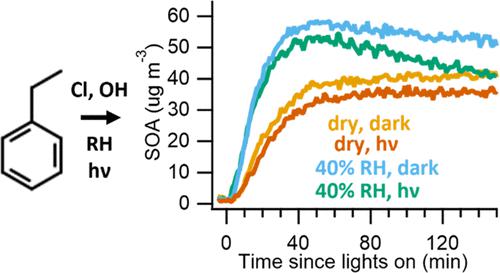当前位置:
X-MOL 学术
›
ACS Earth Space Chem.
›
论文详情
Our official English website, www.x-mol.net, welcomes your feedback! (Note: you will need to create a separate account there.)
Effects of Relative Humidity and Photoaging on the Formation, Composition, and Aging of Ethylbenzene SOA: Insights from Chamber Experiments on Chlorine Radical-Initiated Oxidation of Ethylbenzene
ACS Earth and Space Chemistry ( IF 3.4 ) Pub Date : 2024-04-01 , DOI: 10.1021/acsearthspacechem.3c00279 Leif G. Jahn 1 , Kristi N. McPherson 1 , Lea Hildebrandt Ruiz 1
ACS Earth and Space Chemistry ( IF 3.4 ) Pub Date : 2024-04-01 , DOI: 10.1021/acsearthspacechem.3c00279 Leif G. Jahn 1 , Kristi N. McPherson 1 , Lea Hildebrandt Ruiz 1
Affiliation

|
The oxidation of alkyl-substituted aromatic molecules produces oxygenated volatile organic compounds (OVOCs) and secondary organic aerosols (SOA) that are major components of ambient urban air. Despite their ubiquity, the impacts of variable ambient conditions, such as relative humidity (RH) and actinic exposure, on the physicochemical processes that contribute to SOA formation are still the subject of ongoing research and refinement. In this work, we perform laboratory environmental chamber experiments and use an I– FIGAERO–CIMS to examine the molecular composition of high-NOx ethylbenzene oxidation products and SOA in response to varied relative humidity (dry conditions, 40% RH, and 60% RH) during either dark aging or photoaging (with ∼354 nm UV-A lights). Experiments are performed in a mixed Cl and OH radical environment. Compared to OH chemistry, Cl chemistry forms a greater amount of nitroaromatic products by enhancing benzaldehyde formation and phenolic H abstraction while also forming several organochlorine molecules that may serve as tracers for Cl chemistry, of which C2H3ClO2 (presumably chloroacetic acid) appears to be the most consistent and stable. Organonitrate (ON) molecules undergo hydrolytic and photolytic losses. Nitroaromatic molecules condense more efficiently under humid conditions, presumably due to the relatively high solubility of hydroxy and dihydroxy aromatic molecules, but do not appear stable in the condensed phase during either dark or photoaging. Small oxygenates make up a substantial portion of SOA that increases at high RH (due to increased uptake) and during photoaging (due to SOA photolysis and fragmentation). Photoaging initially leads to a degree of oligomerization in the condensed phase before continued photoaging leads to an eventual loss of these and other compounds. Our results show that RH and photoaging substantially impact the composition and evolution of many gas- and particle-phase species produced during ethylbenzene oxidation and suggest that these environmental factors can exert strong control over SOA formation and evolution, particularly in urban regions.
中文翻译:

相对湿度和光老化对乙苯 SOA 形成、组成和老化的影响:氯自由基引发乙苯氧化室实验的见解
烷基取代的芳香族分子的氧化产生含氧挥发性有机化合物 (OVOC) 和二次有机气溶胶 (SOA),它们是城市周围空气的主要成分。尽管其无处不在,但可变环境条件(例如相对湿度 (RH) 和光化暴露)对有助于 SOA 形成的物理化学过程的影响仍然是持续研究和完善的主题。在这项工作中,我们进行了实验室环境室实验,并使用 I - FIGAERO-CIMS 来检查高 NO x乙苯氧化产物和 SOA的分子组成,以响应不同的相对湿度(干燥条件、40% RH 和 60% RH) RH)在暗老化或光老化(使用~354 nm UV-A 光)期间。实验在 Cl 和 OH 自由基混合环境中进行。与 OH 化学相比,Cl 化学通过增强苯甲醛的形成和酚 H 的提取而形成更大量的硝基芳香族产物,同时还形成一些可作为 Cl 化学示踪剂的有机氯分子,其中 C 2 H 3 ClO 2(可能是氯乙酸)似乎是最一致和稳定的。有机硝酸酯 (ON) 分子会发生水解和光解损失。硝基芳香族分子在潮湿条件下缩合更有效,可能是由于羟基和二羟基芳香族分子的溶解度相对较高,但在暗老化或光老化期间在缩合相中似乎不稳定。小含氧化合物占 SOA 的很大一部分,在高相对湿度(由于吸收增加)和光老化过程中(由于 SOA 光解和碎裂)会增加。光老化最初导致凝聚相中的一定程度的低聚,然后继续光老化导致这些和其他化合物的最终损失。我们的结果表明,相对湿度和光老化极大地影响乙苯氧化过程中产生的许多气相和颗粒相物质的组成和演化,并表明这些环境因素可以对 SOA 的形成和演化发挥强有力的控制作用,特别是在城市地区。
更新日期:2024-04-01
中文翻译:

相对湿度和光老化对乙苯 SOA 形成、组成和老化的影响:氯自由基引发乙苯氧化室实验的见解
烷基取代的芳香族分子的氧化产生含氧挥发性有机化合物 (OVOC) 和二次有机气溶胶 (SOA),它们是城市周围空气的主要成分。尽管其无处不在,但可变环境条件(例如相对湿度 (RH) 和光化暴露)对有助于 SOA 形成的物理化学过程的影响仍然是持续研究和完善的主题。在这项工作中,我们进行了实验室环境室实验,并使用 I - FIGAERO-CIMS 来检查高 NO x乙苯氧化产物和 SOA的分子组成,以响应不同的相对湿度(干燥条件、40% RH 和 60% RH) RH)在暗老化或光老化(使用~354 nm UV-A 光)期间。实验在 Cl 和 OH 自由基混合环境中进行。与 OH 化学相比,Cl 化学通过增强苯甲醛的形成和酚 H 的提取而形成更大量的硝基芳香族产物,同时还形成一些可作为 Cl 化学示踪剂的有机氯分子,其中 C 2 H 3 ClO 2(可能是氯乙酸)似乎是最一致和稳定的。有机硝酸酯 (ON) 分子会发生水解和光解损失。硝基芳香族分子在潮湿条件下缩合更有效,可能是由于羟基和二羟基芳香族分子的溶解度相对较高,但在暗老化或光老化期间在缩合相中似乎不稳定。小含氧化合物占 SOA 的很大一部分,在高相对湿度(由于吸收增加)和光老化过程中(由于 SOA 光解和碎裂)会增加。光老化最初导致凝聚相中的一定程度的低聚,然后继续光老化导致这些和其他化合物的最终损失。我们的结果表明,相对湿度和光老化极大地影响乙苯氧化过程中产生的许多气相和颗粒相物质的组成和演化,并表明这些环境因素可以对 SOA 的形成和演化发挥强有力的控制作用,特别是在城市地区。



























 京公网安备 11010802027423号
京公网安备 11010802027423号